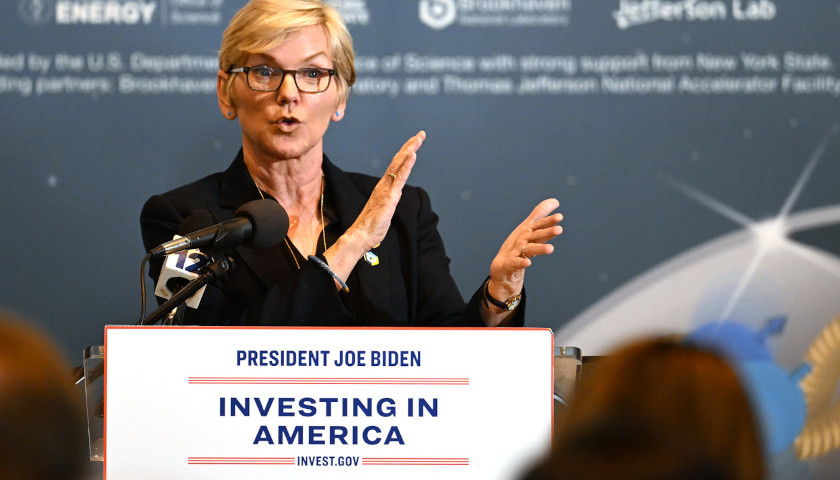by Mark Hemingway
Democrats who advanced a bill in June to remove statues of white supremacists from the U.S. Capitol ignored a central fact about those figures: All of them had been icons of their party, from Andrew Jackson’s adamantly pro-slavery vice president, John C. Calhoun, to North Carolina Gov. Charles B. Aycock, an architect of the white-supremacist campaign of 1898 that ushered in the era of Jim Crow.
At a time when governments, sports teams, schools and other bastions of American society are rushing to expunge legacies of slavery or racism, this was another instance of the Democratic Party’s failure to acknowledge that it did more than any other institution in American life to preserve the “peculiar institution” — and later enforce Jim Crow-style apartheid in the Old South.
“I think it’s absolutely fair to criticize the history of the Democrat Party when we’re literally changing the names of birds because they’re named after racists,” said Jarrett Stepman (pictured above), author of “The War on History: The Conspiracy to Rewrite America’s Past,” referring to a new racism-cleansing push in, yes, ornithology.
Democrats’ circumspection in the face of this trend is especially noteworthy because it comes at a time when they are criticizing Republican legislation to block the teaching of critical race theory on the ground that the GOP wants to whitewash American history. But one of the most noteworthy efforts to reframe American history in terms of race, the New York Times’ 1619 Project, virtually ignores the Democrat Party’s role in advancing and sustaining racism in the United States.
Named after the year slaves from Africa were first brought to North America, the curated collection of essays on race in America presents even the most complex modern issues – from obesity and traffic jams to capitalism itself – as being primarily a consequence of America’s history of slavery and racial injustice. The 1619 Project has been widely adopted as an historical framework on the left despite criticism from eminent historians, being repudiated by the 1619 Project’s own fact-checkers, and mangling basic facts.
Yet, in the essay texts, the Democratic Party is named only three times, in passing. The Republican Party, the political entity formed to fight slavery, also receives little mention. But when the GOP is mentioned, it is excoriated as the 21st century heir to 19th century racist ideology.
For critics of the 1619 Project, the virtual omission of any discussion of the Democratic Party is not only galling but revealing. In their view, the goal of the 1619 Project is neither historical nor educational – it’s thoroughly political. “[1619 Project editor] Nikole Hannah-Jones has been explicit about saying that the point of her essay and the point of the 1619 Project more broadly is to get a reparations bill passed. So that’s a partisan objective,” says Lucas Morel, a professor at Washington and Lee University who has authored books on Abraham Lincoln and Ralph Ellison.
Hannah-Jones did not respond to a request for comment, nor did Jake Silverstein, the editor of the Times Sunday magazine, where the essays originally appeared.
Peter Wood, head of the National Association of Scholars and author of “1620: A Critical Response to the 1619 Project,” agrees that politics is a likely explanation for the 1619 Project’s significant analytical failing.
“If you’re going to be leveraging this project in order to persuade Congress to pass legislation that would entail spending many billions of dollars giving money to the descendants of former slaves, then you need to court favor with the political party that is most likely to advance that agenda,” he says. “At least from Nikole Hannah-Jones’ perspective, I would think that the careful avoidance of casting shade on the Democratic Party fits with her longer-term agenda of extracting wealth from the American people and transferring it to a subset of American people who can prove they are descendants from slaves.”
Historians also note that applying the 1619 Project’s standards for evaluating historical racism could prove especially awkward for Democrats. “I think the history of the Democratic Party is even more problematic than anyone suggests, and the time period of its ‘criminality’ is very long indeed,” says historian Jay Cost, author of several books including “Spoiled Rotten: How the Politics of Patronage Corrupted the Once Noble Democratic Party and Now Threatens the American Republic” and a forthcoming biography of James Madison.
It would be difficult to overstate the Democratic Party’s enduring and baleful role in slavery and racism. Its origins in the 1820s are closely aligned with Martin Van Buren, Jackson’s second vice president and later president himself. Van Buren was a New York power broker whose efforts supporting slavery, partly in the name of preserving the union, earned him the moniker “a northern man with southern principles.”
The Democratic southern states, such as Georgia, specifically criticized the anti-slavery policies of President Lincoln’s Republican Party in their declarations of succession in the Civil War. Even after the war, Cost notes, the Democratic Party’s “central purpose in the second half of the 19th century was specifically to prevent civil rights legislation from being implemented.”
In response to black Republicans being elected in Southern states during Reconstruction, it was Democrats who enacted poll taxes and literacy tests to suppress the black vote. A Democratic president, Woodrow Wilson, resegregated the federal work force in Washington and hosted a White House screening of D.W. Griffith’s egregiously racist, white supremacist “Birth of a Nation.” As late as 1952, the running mate of Democratic presidential candidate Adlai Stevenson, John Sparkman, was an open segregationist. A significantly higher percentage of congressional Republicans voted for the 1964 Civil Rights Act than did congressional Democrats, and segregationists such as George Wallace were major figures in the Democratic Party until the 1970s.
Even during President Obama’s tenure, Robert Byrd, a former Exalted Cyclops of his local KKK chapter, was one of the most powerful Democrats in the Senate.
The absence of Democratic Party critiques is all the more conspicuous when you consider that the 1619 Project doesn’t shy away from critiquing the GOP. New York Times columnist Jamelle Bouie’s contribution to the 1619 Project begins by purporting to explain the “strain of reactionary extremism that has taken over the Republican Party.” Bouie traces this “reactionary extremism” directly back to John C. Calhoun, who famously argued that slavery was a “positive good.” Morel has written at length about his puzzlement over how Bouie can determine historical culpability for the Republican Party:
Remarkably, Bouie manages to explain reactionary politics in the South, from secession over Abraham Lincoln becoming President to “solid blocs of Southern lawmakers” and “reactionary white leaders” resisting federal regulation of their region up until the 1965 Voting Rights Act, all without mentioning it was the Democratic Party in control of those southern states. Bouie thinks that Republicans today are somehow the heirs of an institution that owes its defense and longevity in American history almost entirely to the historical Democratic Party.
He argues that “a homegrown ideology of reaction in the United States, inextricably tied to our system of slavery,” has outlived some but not all of its racist origins and concludes that today’s Republican opposition to Democratic policies “are clearly downstream of a style of extreme political combat that came to fruition in the defense of human bondage.”
Morel observes this is a dubious argument, either as a matter of journalism or history, and “any objective reader, I don’t care what your political party is, would have to conclude it is a hit piece on the modern Republican Party.” Bouie did not respond to a request for comment.
What Morel finds most alarming is that the Pulitzer Center, co-sponsor of “1619,” immediately turned the project into K-12 course materials now in use in thousands of classrooms. The study guide that accompanies Bouie’s essay asks students to answer the question: “According to the author, how do 19th century U.S. political movements aimed at maintaining the right to enslave people manifest in contemporary political parties?”
In a courtroom, that would be called leading the witness. Students given this curriculum are going to be expected to give only one correct answer, though that answer is more a matter of indoctrination than education. “Bouie identifies only one contemporary political party as the heir of 19th-century racist politics — namely, the Republican Party,” Morel writes. “By omitting the reactionary politics of the historical Democratic Party — for example, the ‘Massive Resistance’ to school desegregation in the 1950s — the only evidence presented in the essay implicates the Republican Party.”
An honest accounting would acknowledge that contemporary racial issues have a complicated history that implicates both major parties. The problem, illustrated by the 1619 Project, is that the media and other increasingly left-leaning institutions are invested in historical narratives that help achieve specific political ends.
Peter Wood suggests that the New York Times itself seems to have used the 1619 Project as part of the paper’s broader agenda to affect the outcome of the 2020 election. While the Times committed to doing the 1619 Project in January of 2019, Wood observes that “the hope of energizing the Democratic electorate to oppose Trump in the 2020 election” was one of the animating reasons the Times featured and promoted the 1619 Project so prominently.
To that end, Wood notes the timing of the 1619 Project’s publication in August of 2019 came just one month after “the failure of the Mueller investigation to deliver the results that the Times eagerly anticipated (the 1619 Project was intended as part of what New York Times executive editor Dean Baquet called a ‘pivot,’ from Trump as Russian collusionist to Trump as the face of white supremacy).”
“It’s almost like history is being used as like a vast oppo research thing to make things that they don’t like in the present look bad,” says Stepman. “I think it really comes down to power.”
The Times is hardly alone in distorting history. USA Today ran an article last year headlined: “Fact check: Democratic Party did not found the KKK, did not start the Civil War.”
“I was honestly quite amused reading through the USA Today ‘fact check’ last year saying that the Democrats weren’t really the party of slavery and the KKK,” says Stepman. “They came up with all these various caveats – ‘Well, you know, it wasn’t all Democrats; it was only most Democrats in the South.’ I’m thinking, if this was literally any other institution, if this was the name of a street, or if this was a statue, it would have been immediately canceled. It might have even been ripe for being torn down by a mob.”
To the contrary, USA Today is now one of Facebook’s official fact-checking partners. After the right-leaning Media Research Center published an article critical of USA Today’s fact check absolving the Democratic Party of its ugly legacy, Facebook started censoring the MRC.
One can recognize that the Democratic Party is conscious of its problematic past — for example, many of its organizations have renamed Jefferson-Jackson Day fundraising dinners to avoid any racist taint – and yet still see why it’s problematic to whitewash its racist history.
“[Nikole Hannah-Jones] produced a partisan polemic and left out anything in the historical record that wouldn’t help her make the case. They’re trying to shape how people think about our past so that what happens going forward will of course follow a particular liberal agenda,” Stepman says. “This is a travesty of history and the fact that it’s being taught in high schools is rank partisanship. Believe me, I would rather be doing other things than correcting her errors, but the fact that her errors are being printed as gospel and sold as gospel, that’s a problem. It’s a problem for civic education, and it’s a problem for our cohesion and our unity as a nation.”
– – –
Mark Hemmingway is a writer for Real Clear Investigations.
Background photo “Jim Crow Protest” by Underground Railroad History, photo “Jarrett Stepman” by Jarrett Stepman.






Who do they think they are fooling?